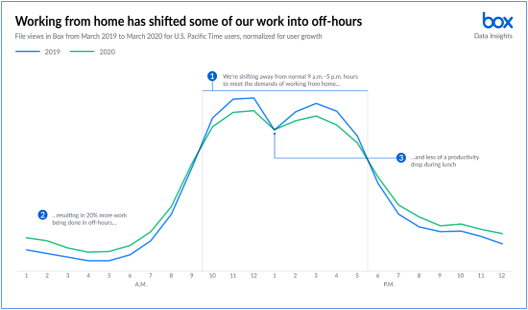1. What changes did remote work start?
A report from Box, a software company, shows that one of the first “victims” of switching to remote work was traditional 9-17 hours. The shutdown of schools and kindergartens, meant for many of us additional challenges with time management, which resulted in the increase of activities outside office hours by 20% (chart). Another unfortunate effect was “lunch” during the teams or Skype meetings instead of proper “lunch break”. This study was done at the beginning of European lockdown – the latest data indicate that a large percentage of people work from home … liked. The newest edition of the Forbes study reports that 2/3 of employees assess remote work better than at the beginning of lockdown.

2. Come back or not come back?
… this is a question that many managers ask themselves.On the one hand, we have “dry run market”, that is China and a over a million employees returning from 10,000 companies returning to the offices and Apple’s assurance that employees will come back to their offices in June. On the other hand, statements from Twitter, Zoom or Box about remote work till the end of the year and plans to modify the outdated and expensive model of office work. Which solution is better we will see in the coming months, but in both cases, companies announce the irreversible evolution of office work. What does it mean exactly?
3. New rules in the new office world
First of all – words such as “open space” are a thing of the past. In China, where employees are returning, companies modify the office space to avoid employees’ contact as much as possible (some Chinese companies have introduced an absolute ban on chatting in kitchenettes, which I suspect would end up in strike in Poland).Secondly – technological support in the fight for the purity of air and surfaces that we use in the office. Solutions such as purifiers and antibacterial lamps as well as taking employees’ temperature should help.
Thirdly – and most importantly – is to develop a new philosophy of remote work and team management. Lack of direct – daily interaction will require managers to show a high level of trust in their team and new competences in this area.
Source: https://blog.box.com/work-unleashed-where-when-and-how-we-work-changing

